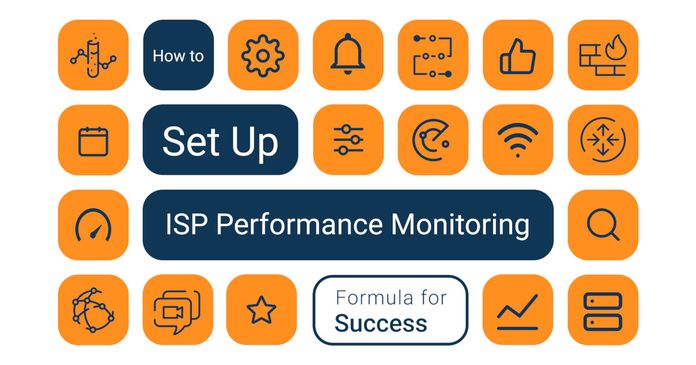Table of Contents
Table of Contents
As our networks change and evolve, businesses alike are increasingly reliant on the Internet for communication, collaboration, and data exchange. With the demand for uninterrupted connectivity at an all-time high, many businesses are turning to Internet multihoming setups to enhance their network performance and ensure a seamless online experience for their users.
Internet multihoming involves connecting a network to multiple Internet Service Providers (ISPs), creating a redundant and robust infrastructure that can withstand potential outages and bottlenecks. While the advantages of multihoming are apparent, ensuring its effective implementation and ongoing performance is crucial to maintaining optimal user experience.
In this blog post, we delve into the details of monitoring an Internet multihoming setup. Whether you are a network administrator striving to enhance reliability or an IT enthusiast exploring the world of multihoming, this blog post aims to provide valuable insights and practical tips to help you navigate the complexities of monitoring and managing a multihomed network. From understanding the fundamentals to implementing proactive monitoring strategies, join us on a journey to unlock the potential of a seamlessly interconnected digital experience.
Internet multihoming is a networking strategy in which an organization connects its network infrastructure to multiple Internet Service Providers (ISPs) simultaneously. The primary goal of multihoming is to enhance network reliability, fault tolerance, and performance by having redundant connections to the Internet.
The implementation of multihoming often involves the use of the Border Gateway Protocol (BGP), which is a standardized exterior gateway protocol used to exchange routing and reachability information between different autonomous systems (ASes) on the Internet. BGP allows organizations to announce their IP address prefixes through multiple ISPs, enabling efficient traffic routing and failover mechanisms.
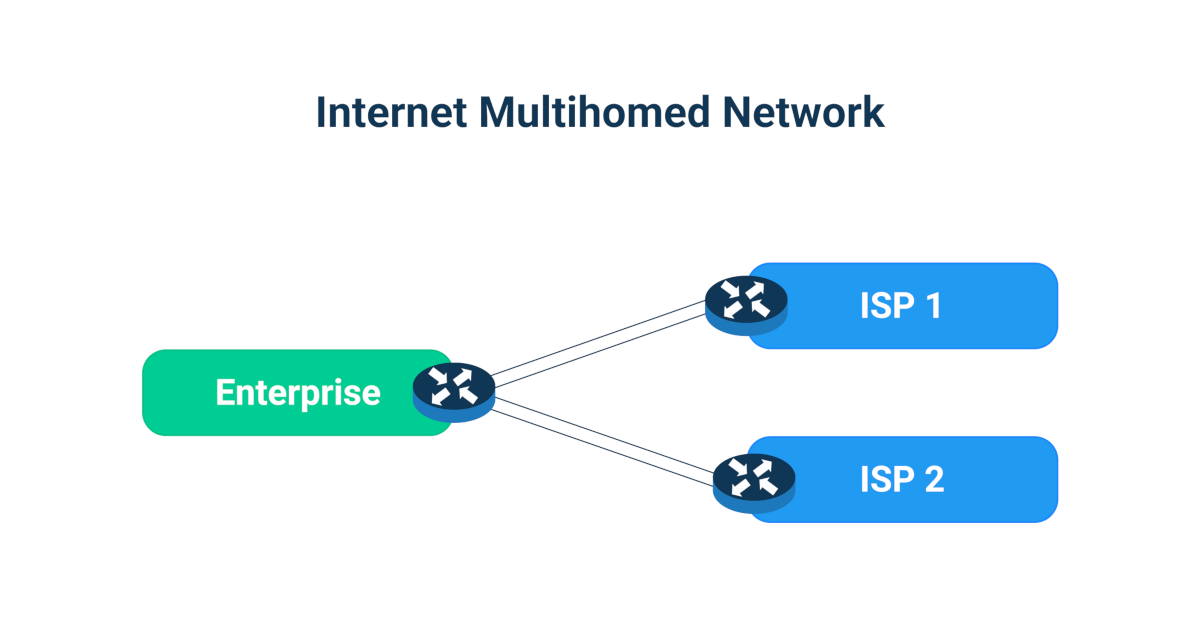

An Internet multihoming architecture involves connecting a network to multiple Internet Service Providers (ISPs). The specific architecture can vary based on the organization's requirements, but here's a general overview of what an internet multihoming setup might look like:
Router/Gateways: The core of the Internet multihoming architecture is the routers or gateway devices responsible for managing the connections to multiple ISPs. These devices handle the routing of traffic between the organization's internal network and the external ISPs.
Multiple ISP Connections: The organization establishes connections to two or more ISPs, each providing internet connectivity. These connections are often implemented using different technologies (e.g., fibre, DSL, cable) or may involve diverse physical paths to enhance redundancy.
BGP Peering: The Border Gateway Protocol (BGP) is typically used for routing between the organization and each ISP. BGP allows the announcement of IP address prefixes and facilitates the exchange of routing information between the organization's autonomous system (AS) and those of the ISPs.
IP Address Blocks: The organization obtains IP address space from each ISP, resulting in multiple IP address blocks. These addresses are used to identify and route traffic to and from the organization's network.
BGP Configuration: The routers are configured with BGP settings to establish peering sessions with each ISP. BGP policies are defined to determine how traffic is routed, considering factors such as the path's length, preference, and network performance metrics.
Load Balancing Devices: Load balancing devices or features within the routers are used to distribute incoming and outgoing traffic across multiple ISP connections. This helps optimize the use of available bandwidth and prevents any single link from becoming a bottleneck.
Traffic Engineering: Organizations may implement traffic engineering strategies within BGP to influence the selection of paths for specific types of traffic. This can be based on factors like latency, cost, or specific performance requirements.
Internet Multihoming networks come in many forms, and businesses can choose the setup they need based on their network and Internet requirements. So, which Internet Multihoming type do you have?
1. BGP Multihoming:
BGP multihoming is a prevalent and widely adopted form of internet multihoming. It involves connecting a network to multiple ISPs using the Border Gateway Protocol (BGP) for routing. The BGP protocol enables the dynamic exchange of routing information between the organization's autonomous system (AS) and the ISPs, facilitating effective traffic distribution and failover mechanisms.
2. Policy-Based Routing:
Policy-based routing in multihoming allows organizations to control the flow of traffic based on predefined policies or rules. These policies may consider factors such as network latency, cost, or specific application requirements. Policy-based routing provides a more granular approach to traffic management, allowing organizations to tailor the routing decisions according to their specific needs.

So, you've set up an Internet multihoming architecture for your business —smart move! But here's the secret to making it all work seamlessly: Network Monitoring. This section is all about why keeping a close eye on things is not just a good idea but pretty much essential.
From catching problems before they become full-blown headaches to making sure your Internet traffic is flowing smoothly, we're diving into why network monitoring is essential for Internet multihomed networks. It's not just about fixing stuff when it breaks; it's about optimizing, securing, and making sure your network stays on top of its game.
1. Early Detection of Issues:
Monitoring tools can proactively detect network problems, faults or outages as soon as they happen. Early detection allows for quick response and minimizes downtime, ensuring that the organization's internet connectivity remains robust.
2. ISP Performance Monitoring:
Network Monitoring allows businesses to track the performance of each ISP connection in their Internet multihoming setup. By identifying issues like increased latency or packet loss, administrators can address potential problems before they significantly impact the user experience.
3. Ensuring Load Balancing:
Multihoming often involves load-balancing traffic across multiple ISP connections. Monitoring helps ensure that the load balancing mechanism is functioning as intended, preventing uneven distribution of traffic and potential bottlenecks.
4. Redundancy Validation:
Monitoring verifies the effectiveness of redundancy measures, ensuring that failover mechanisms operate seamlessly when one ISP connection or network component fails. This is vital for maintaining continuous internet connectivity and minimizing service disruptions.
5. Failover Response Time:
Network Monitoring tools can measure the response time of network failover mechanisms. Quick failover times are essential to maintaining a seamless user experience and preventing prolonged interruptions in case of network issues.
6. Bandwidth Utilization:
Use Network Monitoring tools to measure bandwidth utilization across multiple ISP connections. This information helps network admins optimize bandwidth allocation and plan for future capacity upgrades based on actual usage patterns.
7. Quality of Service (QoS) Monitoring:
QoS monitoring helps businesses evaluate the quality of service provided by each ISP. Organizations can assess whether service level agreements (SLAs) are being met and take corrective actions if needed.
8. Capacity Planning:
Monitoring historical network performance data allows businesses to forecast future capacity requirements. This helps businesses with planning for network expansion, upgrades, or changes in ISP connections to accommodate growing demands.
Monitoring is a fundamental aspect of managing a multihomed network. It empowers administrators to proactively address issues, optimize performance, and ensure the overall health and security of the network infrastructure. Regularly reviewing monitoring data allows businesses to adapt to changing network conditions, implement improvements, and maintain a reliable and resilient Internet multihoming setup.
Ready to take your multihoming setup to the next level? Look no further! With Obkio's Network Monitoring tool, you can ensure your internet multihoming network runs like a well-oiled machine.
Obkio Network Performance Monitoring tool is a simple Network Monitoring and Troubleshooting SaaS solution designed to monitor end-to-end network performance from the end user perspective, and to fulfil the need within the industry for a solution that simplifies network monitoring for all network types - including Internet multihomed networks!

- Seamless Monitoring: Gain real-time insights into your network's performance, detect issues before they impact your users, and keep everything running smoothly.
- Precision Monitoring: Obkio's tool lets you dive deep into the nitty-gritty details. From bandwidth utilization to packet loss, get the data you need to make informed decisions.
- Optimization Opportunities: Identify areas for improvement and fine-tune your multihoming strategy based on comprehensive analytics. Get the most out of your bandwidth and ensure optimal traffic distribution.
Ready to unleash the full potential of your multihomed network? Take the first step with Obkio's Network Monitoring tool today. Don't just monitor—master your network!

Internet multihoming, at its core, is a networking strategy that involves connecting a network to multiple Internet Service Providers (ISPs) simultaneously. In simpler terms, instead of relying on a single ISP, organizations with multihoming can juggle connections from two or more providers.
At a fundamental level, multihoming employs the Border Gateway Protocol (BGP) to announce the organization's IP address prefixes to multiple ISPs, allowing for the efficient exchange of routing information across the interconnected networks. This setup lays the groundwork for a more resilient and robust internet connectivity experience.
Understanding this is essential for deploying the proper monitoring setup for your Internet multihoming network. So before we get into the step-by-step on how to monitor, let’s look into the benefits and challenges of this setup, to see where monitoring comes in.
So as we’ve seen, in a multihoming setup, a business typically has more than one connection to the Internet, and it may obtain IP address space from multiple ISPs. This redundancy provides several benefits for a business’ Internet and network performance in general.
- Fault Tolerance: If one ISP experiences a network outage or network issue, the organization can still maintain connectivity through the other ISPs. This helps to minimize downtime and ensures that critical services remain accessible.
- Load Balancing: Multihoming allows for the distribution of network traffic across multiple internet connections, preventing any single connection from becoming a bottleneck. This can lead to better utilization of available bandwidth and improved overall network performance.
- Route Optimization: By connecting to multiple ISPs, an organization can optimize the routing of traffic based on factors such as latency, cost, or other performance metrics. This flexibility can be particularly valuable for applications with specific networking requirements.
- Reduced Dependency on a Single Provider: Multihoming reduces the risk associated with relying on a single ISP. In case of issues with one provider, the organization can continue operating using the other connections.
- Enhanced Network Resilience: The redundant nature of multihoming contributes to increased resilience against network failures, whether they are caused by technical issues, natural disasters, or other unforeseen events.
While Internet multihoming provides valuable benefits, it also requires careful network planning, configuration, and ongoing monitoring to ensure optimal performance and security. Monitoring tools and strategies are crucial for proactively detecting and troubleshooting performance, to fully experience the advantages of an Internet multihoming setup.
- BGP Complexity: Implementing BGP for multihoming requires a deep understanding of the protocol, and misconfigurations can lead to suboptimal routing or security vulnerabilities.
- IP Address Management: Managing IP address space from multiple ISPs can be challenging. Careful coordination and planning are required to avoid IP address conflicts and ensure proper utilization.
- Cost Considerations: While multihoming offers enhanced connectivity, it also comes with additional costs, including fees from multiple ISPs and potential investments in specialized equipment for load balancing and failover.
Understanding the nuances of Internet multihoming, including its benefits, and challenges, lays the groundwork for making informed decisions in implementing and monitoring a resilient and high-performance network infrastructure. Now, on that note, let’s get into it!
To monitor Internet Multiming networks, you need a modern solution that monitors end-to-end network performance to proactively identify network problems and give you end-to-end visibility. Traditional monitoring solutions that focus on your device won’t give you real insight into your network’s performance.
Obkio’s Network Monitoring SaaS solution was born from a need within the industry to simplify network performance monitoring for modern, decentralized networks. Obkio uses a distributed monitoring strategy to monitor modern network architectures (cloud, SaaS, SD-WAN, Dual-WAN) and the real end-user experience. Obkio covers your whole network by monitoring your local network (LAN, VPN), as well as third-party networks (WAN, ISP, and Internet Peering).
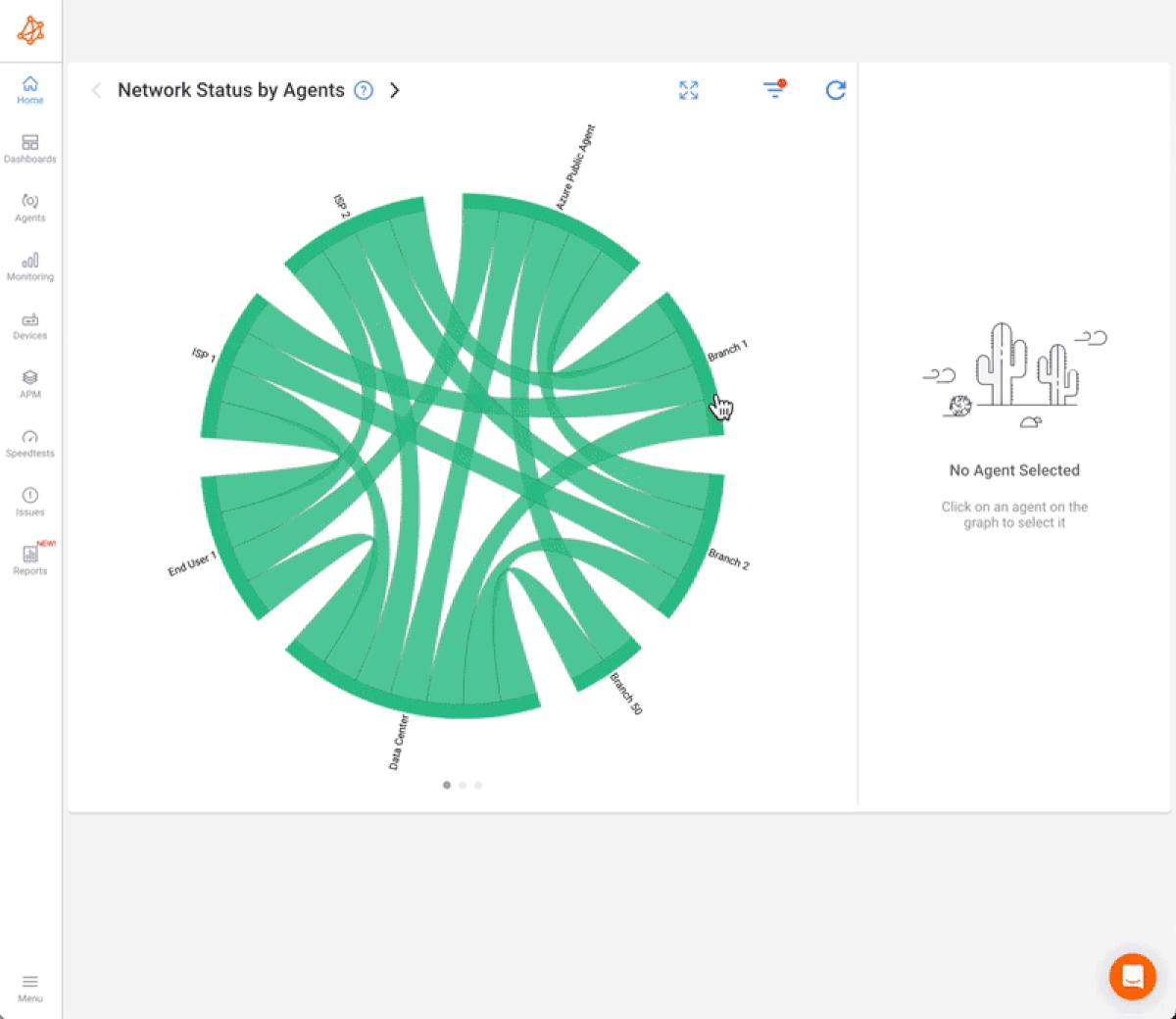
- 14-day free trial of all premium features
- Deploy in just 10 minutes
- Monitor performance in all key network locations
- Measure real-time network metrics
- Identify and troubleshoot live network problems

Obkio leverages Network Monitoring Agents and synthetic traffic to continuously identify the causes of intermittent Internet, VoIP, video, and applications slowdown in seconds - and identify the data you need to troubleshoot and ultimately improve the end-user experience.
Obkio’s Network Monitoring Agents are software deployed in key network locations to monitor your network locations and Internet performance, measure network metrics (latency, jitter, packet loss), and alert you about Internet Multihoming performance issues.
They create Monitoring Sessions and use synthetic UDP traffic for decentralized network monitoring from the source (your computer or your office) up to the destination (another office, data center or clouds). To achieve the level of depth required to monitor an Internet Multihoming network, you need:
Local Agents: These agents are installed in the targeted network locations you want to monitor. There are several Agent types available (all with the same features), and they can be installed on MacOS, Windows, Linux and more.
For Internet multihoming, you need visibility over your internal network (LAN), as well as your ISP’s network (WAN), since multihoming uses not one, but two ISP connections. So, you need Agents covering all of these locations.
- Agents in the Business Network: Local agents deployed in the business’ core network locations like offices, data centers, workstations and more.
- Agents in the ISP Network: Agents deployed in your ISP’s network, allowing you to monitor network performance between you and your ISP’s service.
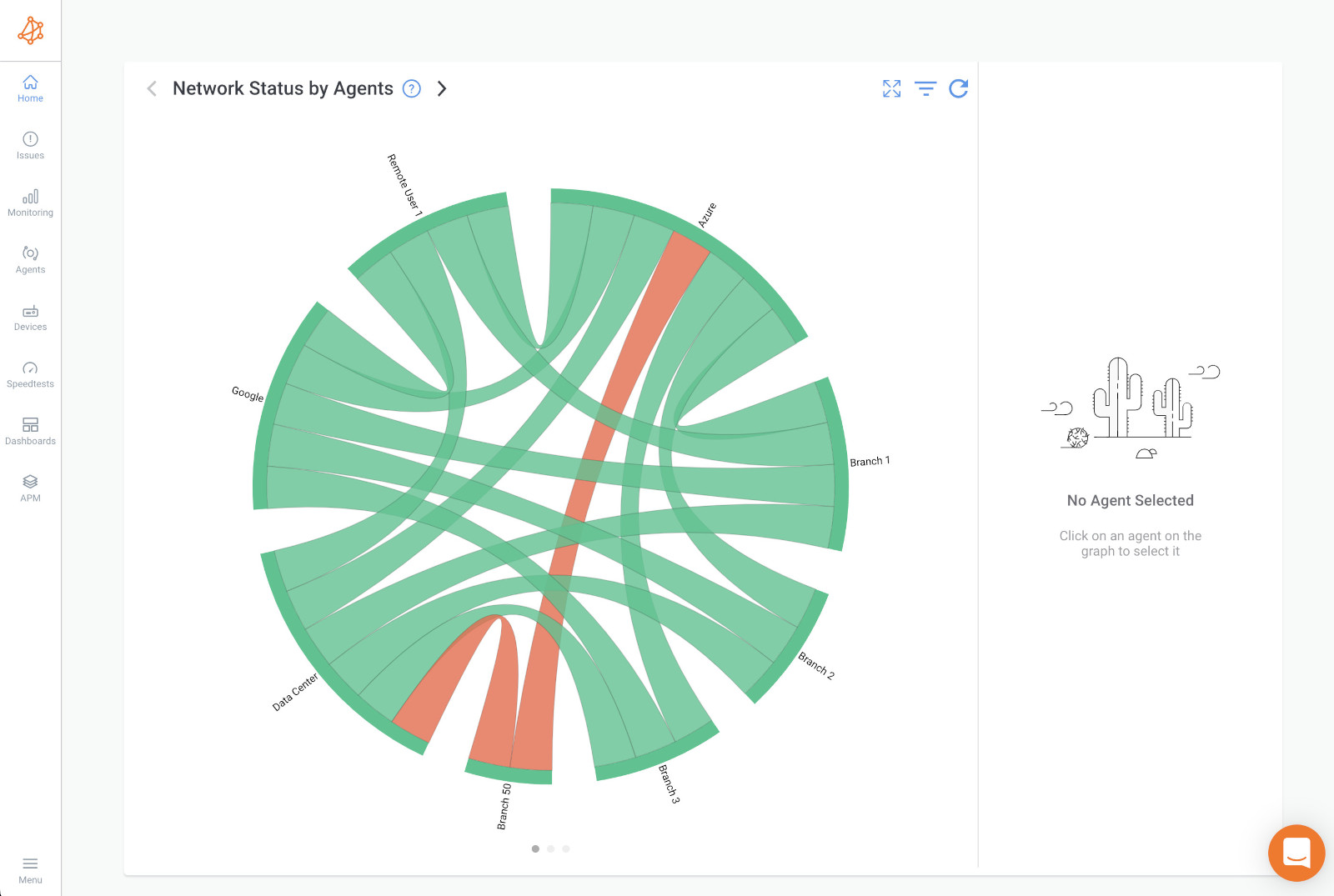
Public Monitoring Agent: These agents are deployed over the Internet and managed by Obkio. They compare performance up to the Internet and quickly identify if the network issue is global or specific to the destination. For example, measure network performance between your head office and your firewall.
- ISP-Managed Agents: Some ISPs can choose to host their own Public Monitoring Agents, allowing their customers to monitor performance up to their infrastructure.
Once deployed, the Monitoring Agents then create Monitoring Sessions by exchanging synthetic UDP packets between every 2 sets of Agents to measure performance metrics and raise alerts for when and if network issues are detected.
Monitoring an Internet multihoming network involves keeping a close eye on various components and aspects to ensure optimal performance, security, and reliability. So when you’re deploying your Monitoring Agents, keep these key elements that should be monitored in an Internet multihoming setup in mind:
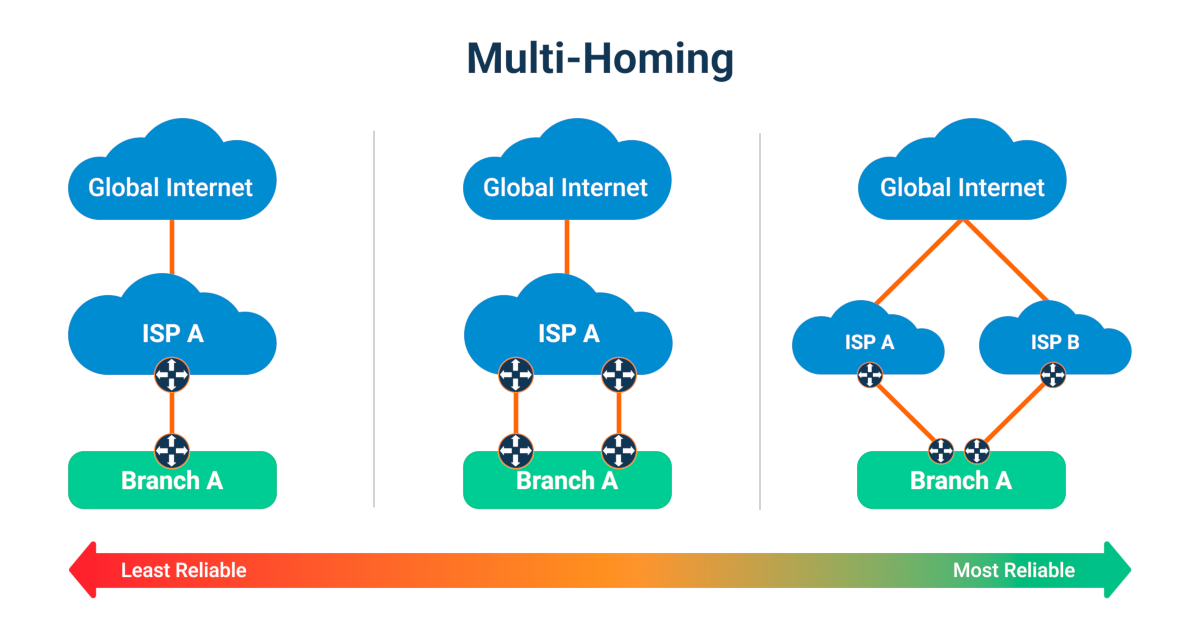
ISP Connections:
- Link Availability: Monitor the availability and status of each ISP connection. Track link up/down events to identify potential connectivity issues with individual ISPs.
- Latency and Packet Loss: Measure the latency and packet loss on each ISP connection. Elevated latency or packet loss can impact the quality of the network and user experience.
- Bandwidth Utilization: Keep an eye on the bandwidth usage of each ISP connection to ensure that traffic is evenly distributed and that no single connection is overloaded.
Routers and Gateway Devices:
- Device Health: Monitor the health and performance of routers and gateway devices. Track metrics such as CPU utilization, memory usage, and temperature to identify potential hardware issues.
- BGP Status: Check the status of Border Gateway Protocol (BGP) sessions with each ISP. Monitor for changes in BGP routing information, route flapping, or inconsistencies.
- Routing Tables: Monitor the routing tables to ensure that the correct routes are being advertised and received. Detect any anomalies in the BGP routing tables that may impact traffic flow.
Load Balancing and Traffic Distribution:
- Balancing Effectiveness: Monitor the effectiveness of load balancing mechanisms. Ensure that traffic is distributed appropriately across multiple ISP connections based on predefined policies and criteria.
- Traffic Engineering: Evaluate the success of traffic engineering strategies. Monitor the performance of specific routes and paths to optimize traffic distribution and achieve desired network outcomes.
Redundancy and Failover:
- Failover Time: Measure the time it takes for failover mechanisms to activate in the event of a connectivity issue. Ensure that failover occurs quickly to minimize downtime.
- Redundancy Validation: Regularly validate the redundancy configurations to confirm that backup paths and connections are operational.
Network Locations:
- Branch Offices: If applicable, monitor the connectivity and performance of branch offices connected to the multihomed network. Ensure that remote locations experience reliable internet access.
- Data Centers: Monitor the connectivity and performance of data centers connected to the Internet multihoming setup. Verify that critical services hosted in data centers remain accessible.
Overall Network Health:
Implement a centralized network monitoring dashboard that provides an overview of the entire Internet multihoming network. This dashboard should display key performance indicators, alerts, and status information for quick and efficient monitoring. Obkio’s Network Monitoring tool allows you to customize your own dashboards as you wish.
Regular and proactive monitoring of these components and network locations is essential to identify issues, optimize performance, and maintain the robustness of an internet multihoming setup. In the next sections, we’ll dive into each of these in more detail.
We talked about this earlier but it’s so important that it needs its own section. In an Internet multihoming setup, the effectiveness of the entire network hinges on the seamless operation of individual ISP connections. Monitoring these connections is not just a good practice; it's a mission-critical aspect that directly impacts the reliability, performance, and overall health of the network.
Using Obkio’s Network Monitoring tool, ISPs can deploy Monitoring Agents in their network to allow customers to monitor performance between the ISP network and the client network. This ensures that ISPs can proactively identify issues affecting their customers and that customers can ensure the quality and speed of their Internet connections.
We dive into this more in our article on “How to Set Up ISP Performance Monitoring.”
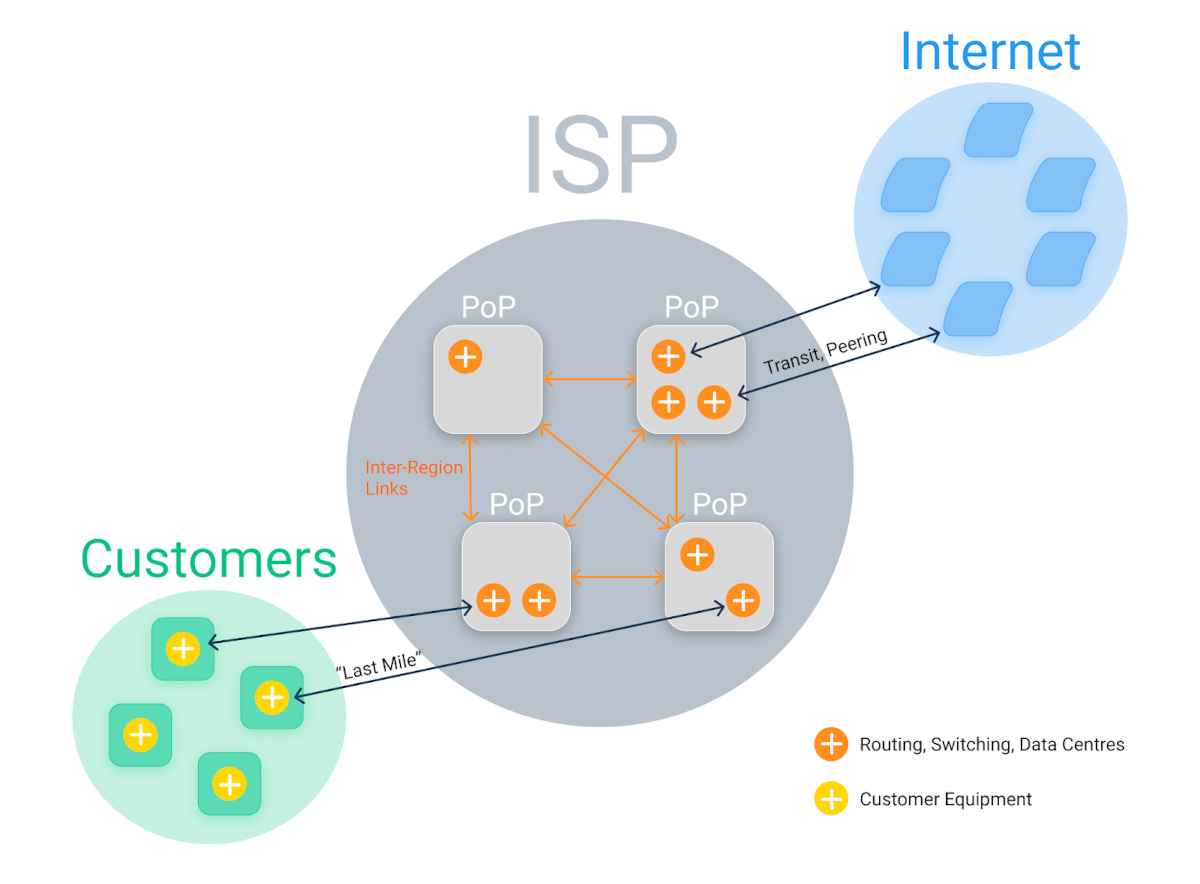
When monitoring ISP performance, here are some key elements to look into:
1. Customer Connections: Monitoring client connections allows ISPs and customers to proactively detect network issues, such as equipment malfunctions, signal strength discrepancies, and connectivity issues that are individualized to specific user experiences. Swift identification and resolution of these client connection problems contribute significantly to an improved service experience and overall customer satisfaction.
2. Infrastructure for the Local ISP Network: Monitoring the local network infrastructure helps identify bottlenecks, signal degradation, or outages in the last-mile connection. The "last mile" link connects the customer's location to the nearest point of presence (PoP) in the ISP's network. This link is crucial for data transmission. Wired connections, like DSL or cable, form the local loop, allowing data to travel to the ISP's headend or central office.
3. Infrastructure of the Central ISP Network PoPs: Monitoring the central infrastructure is essential for identifying and resolving issues related to data aggregation, routing errors, or equipment malfunctions, to prevent significant service disruptions and maintain the stability of the network. The central office or head end serves as the hub where data from various local connections is consolidated and processed, marking the beginning of the ISP's fundamental network. Routers and switches play a crucial role in directing data along the most efficient routes within the ISP's network.
4. The Core Internet Service Provider Network: Monitoring the core network is essential for promptly identifying problems such as equipment failures, congestion, and irregular routing that might jeopardize the ISP's backbone. The backbone infrastructure of an ISP comprises robust, high-capacity connections that link different network segments, often using fibre-optic cables. The ISP establishes connections with other ISPs through peering and transit agreements to facilitate the exchange and routing of data across the broader Internet.
So why is monitoring your ISP connections so important? Well, there’s the obvious reason for ensuring Internet performance, but wait, there’s more.
- Network Availability: Monitoring ISP connections allows for the rapid detection of issues such as link failures or outages. Detecting and troubleshooting network availability issues minimizes downtime, and ensures uninterrupted internet access for users.
- Redundancy Assurance: In an Internet multihoming environment, where redundancy is a key advantage, monitoring verifies that each ISP connection is operational. This ensures that the network can seamlessly switch to an alternative connection if one ISP experiences problems, thereby maintaining continuous connectivity.
- Latency and Packet Loss Monitoring: ISPs may have different network infrastructures and routing paths, leading to variations in latency and packet loss. Monitoring these metrics helps assess the performance of each ISP connection, allowing administrators to optimize traffic routing for better overall network responsiveness.
- Bandwidth Utilization: Monitoring bandwidth usage on individual ISP connections is crucial for optimizing load balancing and preventing congestion. It ensures that traffic is distributed effectively, preventing any single connection from becoming a bottleneck.
- Failover Time: Monitoring ISP connections provides insights into the failover time—the duration it takes for the network to switch from a failed connection to an operational one. Fast failover is essential for maintaining seamless connectivity during disruptions.
- Internet SLA Validation: Regular monitoring ensures that organizations are billed accurately by ISPs, verifying that the charges align with the agreed-upon service levels (Internet SLAs) and usage.
- Quality of Service (QoS): ISPs may offer varying levels of service quality. Monitoring the performance of each ISP connection ensures that the organization can meet its service level agreements (SLAs) and provide a consistent and satisfactory experience for end-users.
- User Experience: Rapidly identifying and addressing issues with ISP connections minimizes disruptions for end-users, contributing to a positive overall experience and avoiding potential business impact.
Discover the secrets to setting up and optimizing ISP performance monitoring with tips from network experts. Monitor Internet SLAs and ISP performance.
Learn more

Monitoring network devices in an Internet multihoming Dual-WAN setup provides insights into the performance of routers, switches, and other network devices. This information helps administrators optimize the configuration, ensuring efficient traffic routing, load balancing, and overall network performance.
Lucky for you, the Network Device Monitoring feature inside of Obkio’s Network Monitoring Software is the perfect tool for monitoring and troubleshooting network device issues. Using SNMP, Obkio’s Network Device Monitoring feature provides businesses with detailed information about the performance of core network devices to quickly and proactively pinpoint and troubleshoot network device issues like congestion, and high CPU and interface errors.

In an Internet multihoming setup, it's essential to monitor various network devices to ensure the stability, security, and optimal performance of the network. Here are the devices that you need to keep your eye on:
1. Routers: Routers play a central role in directing traffic between the organization's network and multiple ISPs.
- Routing tables for BGP stability
- Device health (CPU, memory utilization)
- Interface status and utilization
- BGP session status and changes
2. Switches: Switches facilitate local network traffic within the organization.
- Port status and utilization
- VLAN configurations
- Switch health metrics
3. Firewalls: Firewalls are critical for network security, enforcing access policies, and protecting against unauthorized access.
- Rule effectiveness
- Security event logs
- Throughput and connection counts
4. Load Balancers: Load balancers distribute network traffic across multiple ISP connections, ensuring efficient use of available bandwidth.
- Balancing effectiveness
- Health of load balancer nodes
- Throughput and connection counts
5. Modems and Last-Mile Devices: These devices connect the organization's network to the last-mile infrastructure provided by ISPs.
- Signal strength and quality
- Connection status
- Throughput and Internet latency on last-mile connections
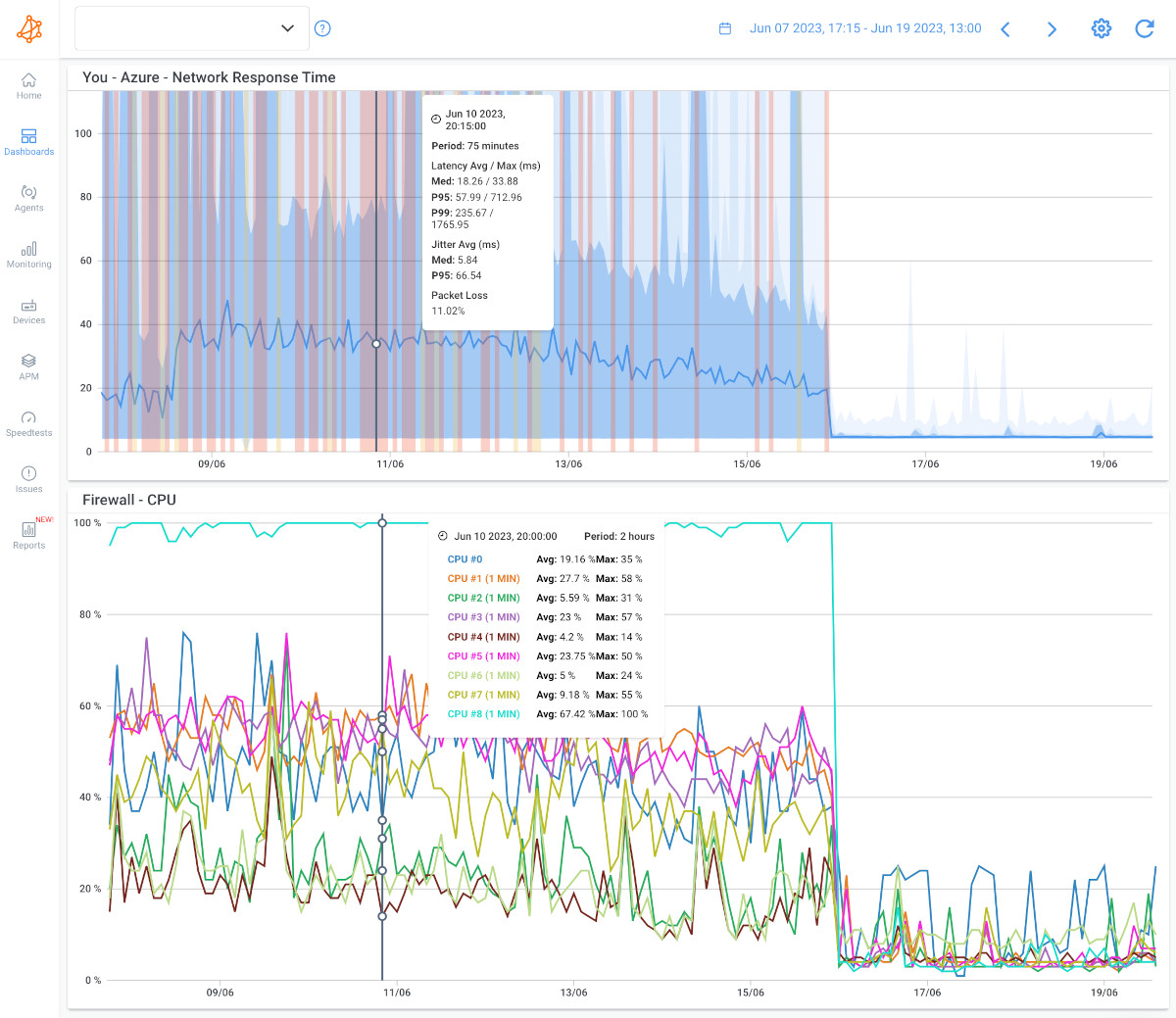
So let’s get into the real MVPs of network performance - the network metrics. By understanding and monitoring metrics like latency, bandwidth, and routing stability, you're not just measuring data; you're fine-tuning performance. These metrics are the key to optimized performance, proactive issue resolution, and fortified security.
When you’ve deployed Obkio’s Network Monitoring tool, Obkio does all the measuring, analyzing and interpreting for you. It continuously measures key network metrics and automatically notifies you when and if your network performance is being affected by performance issues.
But when it comes to an Internet multihoming setup, which metrics are the most important? Let’s take a look!
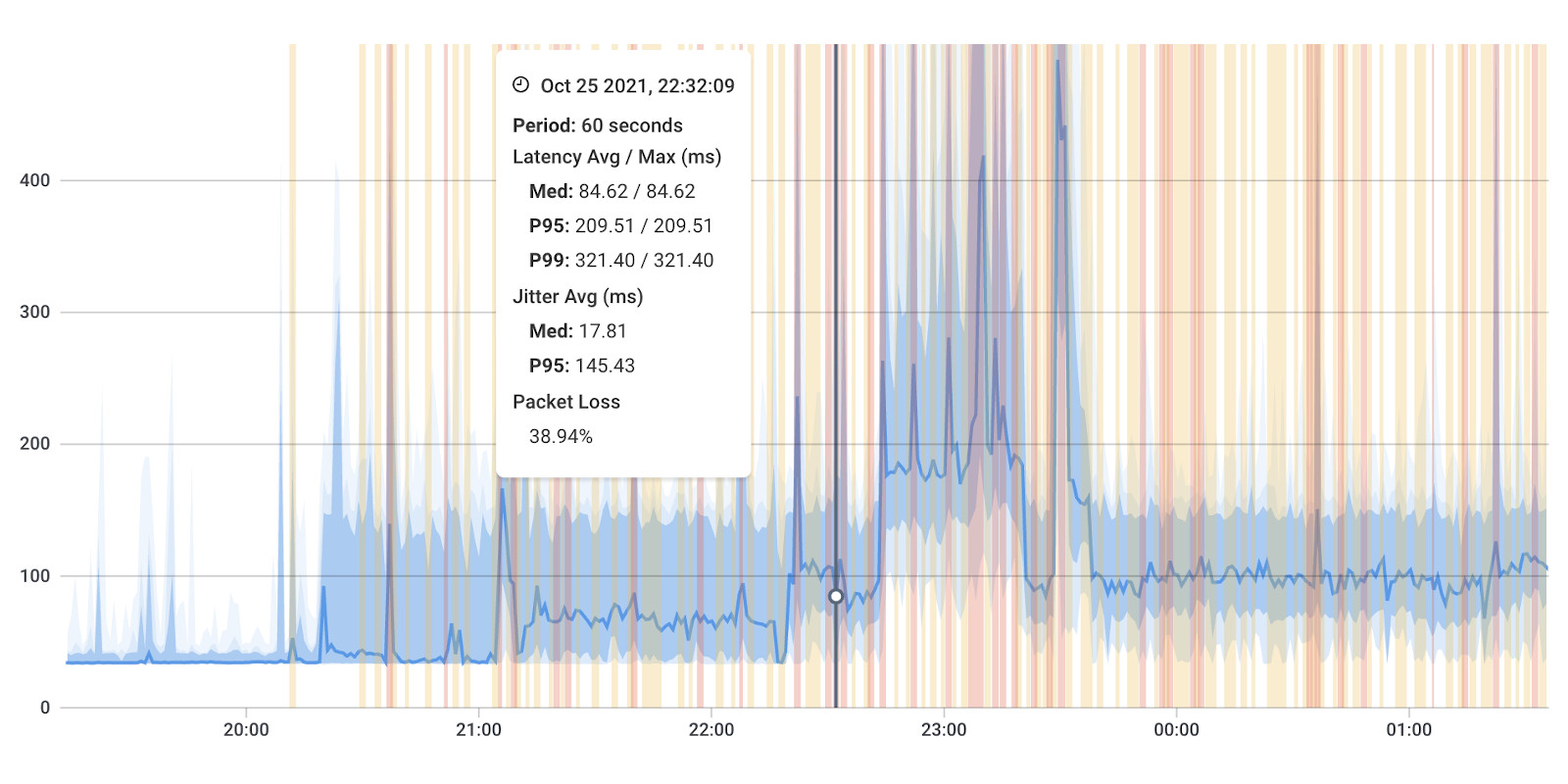
- Latency: The time it takes for data to travel from source to destination. High latency can lead to slow application performance and decreased user experience.
- Packet Loss: The percentage of data packets that do not reach their destination. Excessive packet loss can degrade network performance and impact the reliability of data transmission.
- Bandwidth Utilization: The percentage of available bandwidth that is currently in use. Monitoring bandwidth utilization helps prevent congestion and ensures efficient use of network resources.
- Throughput: The actual amount of data transmitted over the network within a specific time period. Throughput metrics indicate the network's capacity to handle data traffic and help identify potential bottlenecks.
- BGP Routing Metrics: Metrics related to the Border Gateway Protocol (BGP) such as the number of BGP sessions, route changes, and convergence time. Monitoring BGP metrics ensures the stability and efficiency of routing in multihoming setups.
- Availability/Uptime: The percentage of time the network is available and operational. High network availability and uptime is critical for maintaining uninterrupted internet connectivity and service.
- Load Balancing Effectiveness: Metrics related to the distribution of traffic across multiple ISP connections. Ensures that traffic is evenly distributed, preventing congestion on specific links and optimizing overall network performance.
- Failover Time: The time it takes for the network to switch from a failed connection to an operational one. Swift failover is critical for minimizing downtime and maintaining continuous internet connectivity.
- Quality of Service (QoS): Metrics related to the quality of service provided to specific types of traffic. QoS metrics help ensure that critical applications receive the necessary network resources for optimal performance.
Regularly monitoring these network metrics allows administrators to proactively identify issues, optimize performance, and maintain the stability and efficiency of internet multihoming networks. Network monitoring tools streamline the process of gathering and analyzing these metrics for effective network management.
Welcome to the core of Internet multihoming monitoring! When you’re analyzing your Internet multihoming setup, it's not just about establishing connections; it's about ensuring those connections thrive. So let’s take a look at the next steps that are essential in this process: real-time monitoring, proactive alerts, and smart trend analysis.
And here's the tool that simplifies it all—Obkio's Comprehensive Network Monitoring tool.
Think of your Network Monitoring tool as your personal network admin, offering instant data, highlighting potential issues, and providing valuable insights for future planning. It's not just about keeping your network running; it's about making the most of Internet multihoming without unnecessary complications.
Real-time monitoring involves the continuous, instantaneous tracking of network metrics and performance indicators within an Internet multihoming setup. This is what your Network Monitoring tool is best at.
Real-time monitoring is the frontline defence, providing immediate insights into the network's health. It allows administrators to detect and address issues the moment they arise, minimizing downtime and ensuring a responsive and reliable internet connection.
Whether it's identifying sudden traffic spikes, abnormal latency, or unexpected route changes, real-time monitoring is the eyes and ears that keep the network on its toes.
Alerts and notifications are automated messages or warnings triggered by predefined conditions or thresholds in the network, signalling potential issues or deviations from normal operation. With Obkio’s Network Monitoring tool, you can set custom thresholds to ensure that you’re only getting the alerts that matter most.
Alerts and notifications are the key to proactivity, instantly informing network admins of anomalies, breaches, or performance deviations. Whether it's a significant drop in bandwidth, a BGP session disruption, or security concerns, these alerts empower administrators to take swift action, preventing minor hiccups from turning into major disruptions.
Trend analysis involves examining historical network data to identify patterns, trends, and recurring behaviours over time. While real-time monitoring addresses the immediate, trend analysis provides a strategic view into the network's evolution.
By analyzing historical data, administrators can forecast potential challenges, plan for capacity upgrades, and optimize network configurations. Trends in bandwidth usage, latency, or route changes become valuable insights, enabling proactive decision-making for the sustained health and growth of the internet multihoming network.
In a nutshell, these monitoring elements work in tandem to create a comprehensive network management strategy for Internet multihoming setups. Together, they form a robust framework ensuring the agility, responsiveness, and long-term success of your multihoming network.

Internet multihoming, while offering benefits in terms of redundancy and load balancing, can encounter various performance issues.
With Obkio's Network Monitoring tool at your disposal, you gain a holistic view of your Internet multihoming setup, empowering you to proactively identify and address performance issues. Obkio’s real-time monitoring capabilities provide granular insights into metrics like latency, bandwidth utilization, and routing stability. Armed with this comprehensive data, you can pinpoint uneven traffic distribution, monitor BGP route stability, and detect latency variations across different ISP connections.
Alerts and notifications from Obkio act as early warning systems, notifying you instantly of potential bottlenecks or anomalies. So what are some of the network problems you should be looking out for? Let’s go over some of the most common:
1. Network Connectivity Issues
Network connectivity issues in an Internet multihoming network refer to disruptions or inefficiencies in establishing and maintaining connections between the organization and its Internet Service Providers (ISPs). These issues may manifest as network outages, slow data transmission, or intermittent connectivity.
Obkio's Network Monitoring tool excels in swiftly identifying and resolving connectivity issues within your internet multihoming network. By continuously monitoring the health and performance of each ISP connection in real-time, the tool provides instant insights into potential disruptions, last-mile bottlenecks, or network congestion. Armed with this information, administrators can take proactive measures to address connectivity issues, minimizing downtime, and ensuring uninterrupted Internet access for users.
2. Uneven Traffic Distribution
Ineffective load balancing can lead to traffic congestion on some links and underutilization of others. Uneven traffic distribution results in inefficient use of available bandwidth, leading to suboptimal network performance.
By monitoring real-time bandwidth utilization across multiple ISP connections, Obkio enables you to identify imbalances and optimize load-balancing configurations for more efficient traffic distribution.
3. BGP Route Flapping
Route flapping occurs when BGP routes to certain destinations repeatedly go up and down. Frequent route changes lead to network instability, increased convergence time, and potential disruptions in connectivity.
4. Latency Discrepancies
Latency discrepancies occur due to variations in latency across different ISP connections. Uneven latency affects the performance of real-time applications, leading to a degraded user experience.
Obkio's real-time monitoring of latency metrics allows you to identify variations across ISP connections, enabling you to address latency issues promptly and optimize routing for better performance.
5. Suboptimal Routing Decisions
Suboptimal Routing Decisions are caused by inefficient routing decisions that do not consider factors such as latency or cost. Suboptimal routing results in longer data paths, increased latency, and inefficient use of network resources.
Obkio's monitoring tool provides visibility into routing paths and metrics, allowing you to analyze and optimize routing decisions based on factors like latency and cost for improved network efficiency.
6. Bottlenecks in Last-Mile Connections
Inadequate performance or capacity limitations in the last-mile connections from the organization to the ISPs can cause network bottlenecks. Last-mile bottlenecks hinder overall network performance, especially if not addressed promptly.
Obkio's monitoring helps identify performance issues in last-mile connections, allowing you to address bottlenecks, optimize connections, and ensure smooth data transmission.
7. Inefficient Failover Mechanisms
Slow or inefficient network failover mechanisms in the event of an ISP connection failure. Lengthy failover times can result in downtime and disrupt ongoing network activities.
Obkio's real-time monitoring of connectivity and automatic alerting can help identify ISP connection failures promptly, allowing for faster failover responses and minimizing downtime.
8. Lack of Visibility
Insufficient monitoring and visibility into the performance of each ISP connection. Limited visibility hinders the identification of performance issues and proactive troubleshooting.
Obkio's comprehensive monitoring provides detailed visibility into the performance of each ISP connection, helping you proactively identify and address issues before they impact network performance.
9. IP Address Space Challenges
Mismanagement of IP address space from multiple ISPs, leading to conflicts or overlaps. IP address conflicts can disrupt communication and lead to connectivity issues.
10. Limited Traffic Engineering
Inability to effectively engineer and control the flow of traffic across different ISP connections. Limited control over traffic distribution can result in suboptimal network performance.
Obkio's real-time monitoring and alerting allow you to assess traffic patterns and optimize traffic engineering strategies, ensuring efficient utilization of available bandwidth.
In summary, Network Monitoring tools plays a crucial role in addressing and mitigating various performance issues in Internet multihoming networks by providing real-time insights, automated alerts, and comprehensive visibility into network metrics. These tools empower network administrators to proactively manage and optimize their multihoming setups for enhanced performance and reliability.
Learn how to troubleshoot network connectivity issues and escape the frustration with our comprehensive guide. Keep your network healthy and connected!
Learn more

When it comes to troubleshooting performance issues in an Internet multihoming setup, having the right toolkit is crucial. When it comes to ensuring the seamless operation of Internet multihoming setups, troubleshooting is an inevitable aspect.
In this section, we'll explore a focused toolkit designed to identify and resolve performance issues promptly. The network troubleshooting tools we'll discuss—real-time monitoring, traceroute analysis, SNMP, and ping tests—are the frontline warriors in the battle against network anomalies.
Real-time monitoring tools, such as Obkio's Network Monitoring, provide continuous visibility into the performance of your Internet multihoming setup with real-time data on metrics like latency, packet loss, and bandwidth utilization across multiple ISP connections.
By leveraging Obkio's tool, for instance, you can instantly detect spikes in bandwidth usage, identify latency variations, and monitor the overall health of specific ISP connections. This real-time visibility is crucial for promptly addressing performance issues and ensuring optimal network operation.
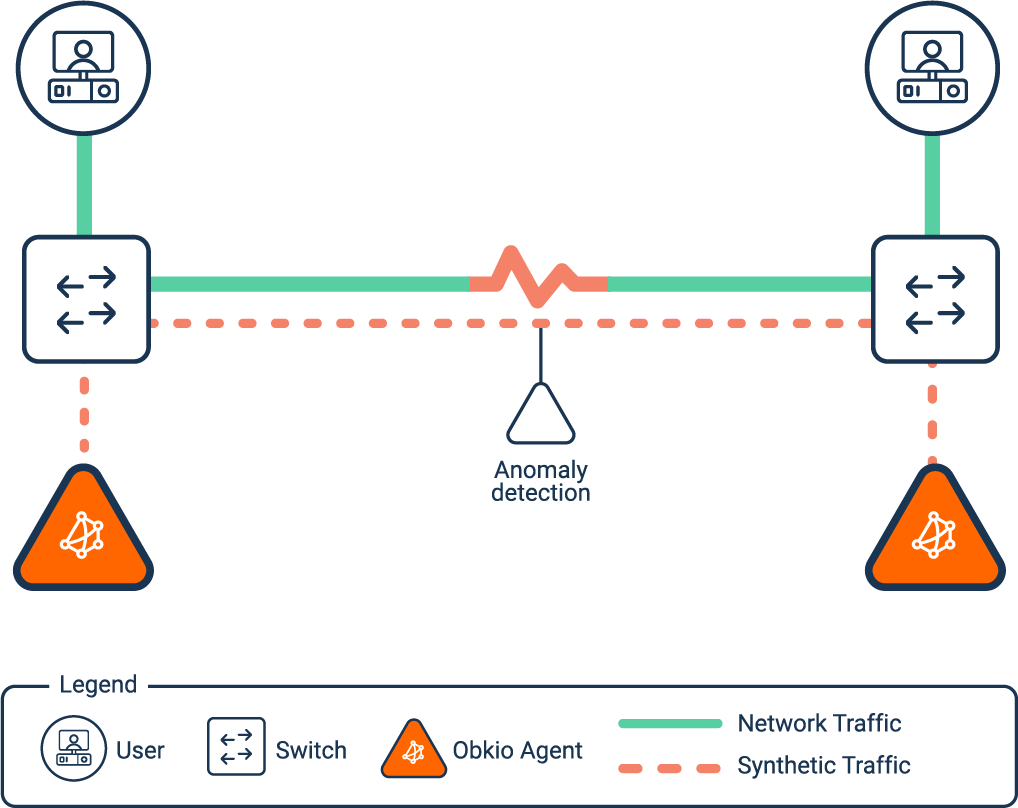

Traceroute is a diagnostic tool that maps the route that data packets take from the source to the destination, revealing the network path and latency at each hop. When troubleshooting, traceroutes help pinpoint the location of latency or packet loss. By analyzing the results, you can identify specific routers or network segments causing issues, allowing for targeted problem resolution.
Tired of traditional traceroutes?
Obkio Vision Visual Traceroute tool is a simplified traceroutes tool that interprets real data for you and identifies Internet and WAN problems more effectively. While traditional text-based Traceroutes show the IP addresses of the intermediate routers or hops along the path to identify network delays or failures, Obkio’s Visual Traceroute tool takes it a step further.
Obkio Vision is Obkio’s free Visual Traceroute tool that runs continuously to interpret Traceroute results for you and helps troubleshoot network problems (in your WAN and over the Internet) faster and easier than ever.
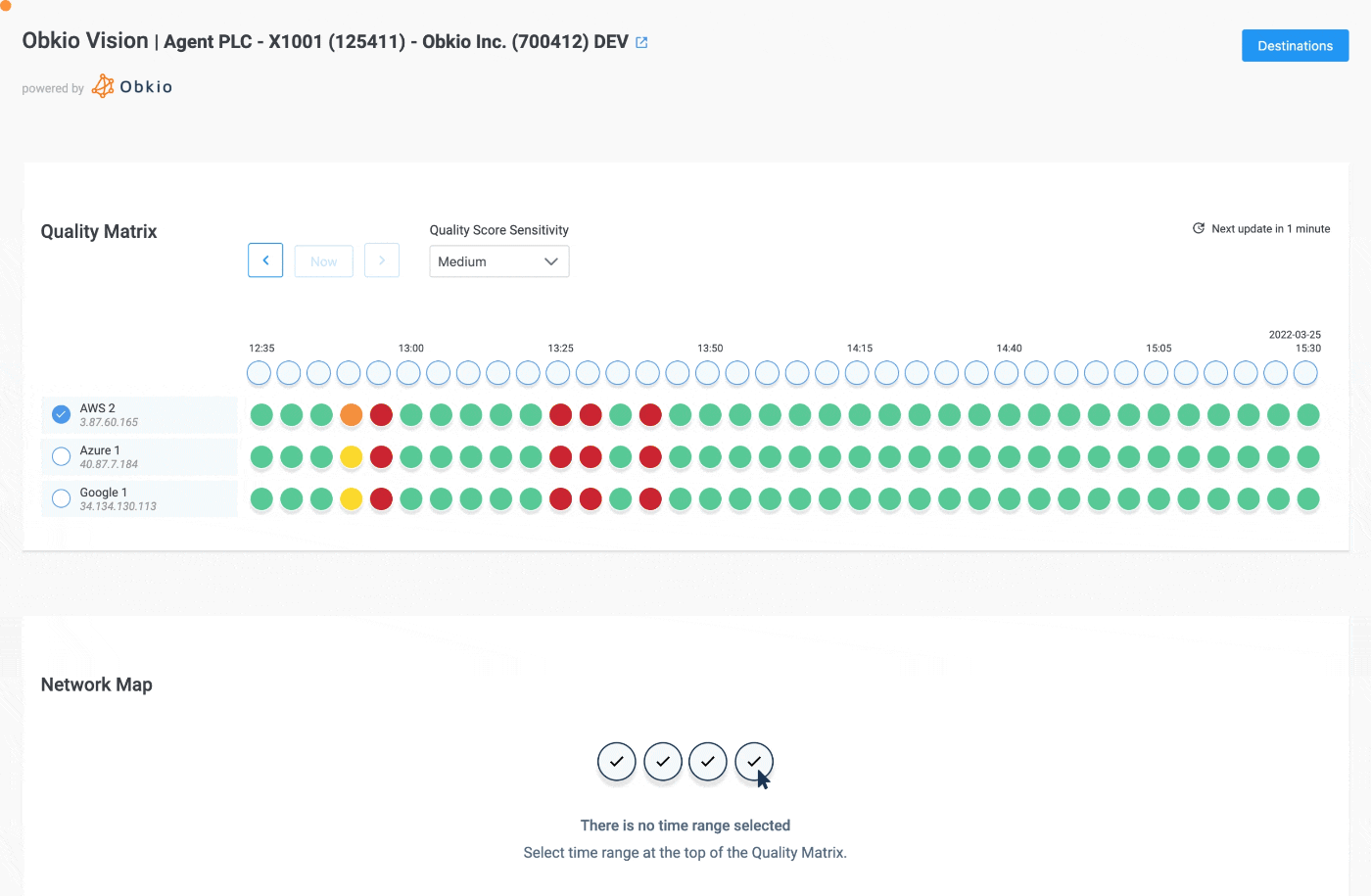
SNMP enables the collection and monitoring of network performance data from devices such as routers and switches. By configuring SNMP on network devices, you can use tools like Nagios or Cacti to gather detailed network statistics on device health, bandwidth usage, and other performance metrics. This information is valuable for proactive issue identification, capacity planning, and optimizing network device configurations.
Ping tests assess the round-trip time for data packets to reach their destination, helping verify basic connectivity and identify potential issues. Regular ping tests provide a network baseline for network performance. Anomalies in response times or packet loss during ping tests can indicate connectivity problems, helping you diagnose and troubleshoot network issues promptly. Tools like PingPlotter offer more advanced visualizations of ping data, aiding in in-depth analysis.
Combining these tools allows for a comprehensive troubleshooting approach. Start by using real-time monitoring tools to identify anomalies, then delve deeper with traceroutes, SNMP data, and specific protocol analysis tools. Remember, the key is a systematic approach, leveraging multiple tools to gather different perspectives on the network's performance and swiftly resolving issues that may arise in an internet multihoming environment.
When it comes to Internet multihoming, ISP connections play a huge part. With so many connections to monitor, it’s sometimes hard to understand whether network issues are coming from your business’ network or your ISP’s network - and who is responsible for fixing them.
Traceroutes and real-time monitoring tools, like Obkio, form a dynamic duo in troubleshooting Internet multihoming performance issues. Traceroutes offer a granular perspective on the network path, showcasing each hop and the associated latency. When integrated with Obkio's Network Monitoring, this combination becomes a powerful diagnostic tool to help you identify where issues are really coming from.
Learn how to use network monitoring tools to identify ISP issues and work with your ISP to troubleshoot. Don't let ISP problems slow you down!
Learn more

Use of Traceroutes:
Conducting traceroutes allows you to visualize the journey of data packets, identifying potential bottlenecks or latency spikes within your internal network. Analyzing the specific hops and response times helps pinpoint issues within your organization's infrastructure.
Obkio's Role:
Supplementing traceroutes with Obkio's real-time monitoring enhances the diagnostic process. It provides detailed insights into latency, packet loss, and bandwidth utilization on specific ISP connections, helping you discern if performance issues originate within your network.
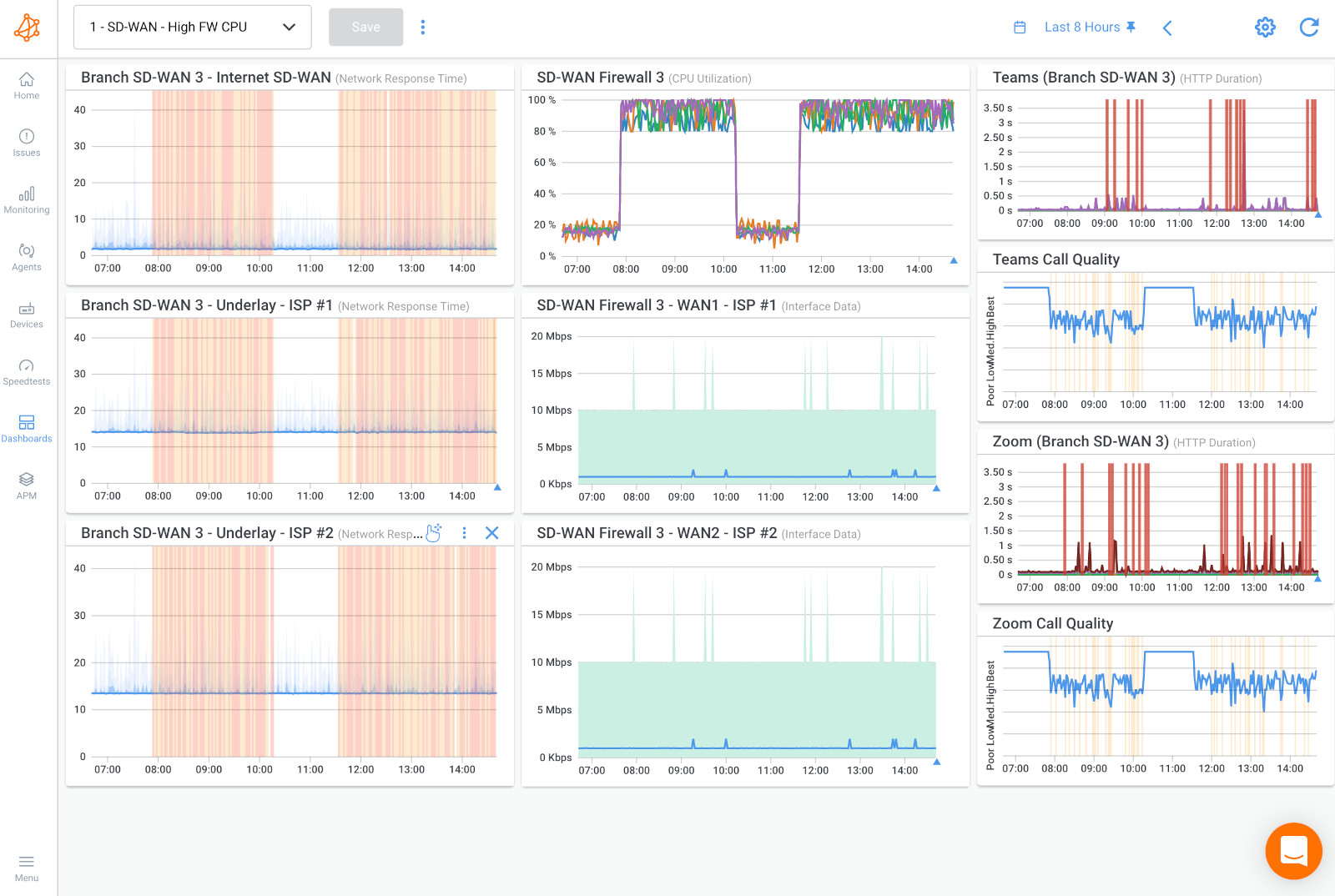
Utilizing Traceroutes:
Traceroutes extend beyond your internal network, shedding light on the path through your ISP. Elevated latency or issues at specific hops in the ISP's network can be identified through traceroutes.
Leveraging Obkio's Strengths:
When coupled with Obkio, you gain a real-time overview of your entire internet multihoming setup. This includes ISP connections, enabling you to distinguish between issues within your network and those occurring within the ISP's infrastructure.
By combining traceroutes and Obkio's Network Monitoring, you gain a comprehensive understanding of the entire data transmission journey. This synergy allows you to discern whether performance challenges originate internally or within your ISP's network, facilitating precise and efficient troubleshooting. Whether it's optimizing internal configurations or collaborating with your ISP for issue resolution, this approach ensures a targeted and effective response to internet multihoming performance concerns.
So we’ve now gone over everything you need to know about understanding, monitoring, diagnosing and troubleshooting your business’ Internet multihoming network. With this information at your fingertips (and on your screen), you can now be prepared for any network issues coming your way.
But before we leave you on this journey, we want to leave you with some final tips. So, here are some best practices to enhance the performance, reliability, and security of your multihoming setup:
Define Clear Objectives: Clearly outline the goals of your multihoming setup, whether it's load balancing, redundancy, or performance optimization. Understanding your objectives helps shape the design and configuration of the network.
Understand Your Traffic Patterns: Analyze your organization's traffic patterns to determine how data flows through the network. This insight allows you to optimize routing decisions and allocate bandwidth effectively.
Implement BGP Best Practices: Follow best practices for Border Gateway Protocol (BGP) configuration. This includes minimizing the number of advertised prefixes, utilizing route aggregation, and implementing prefix filters to enhance BGP stability and reduce the size of the routing table.
Use Provider-Independent Address Space: Utilize provider-independent IP address space to avoid dependency on a single Internet Service Provider (ISP). This ensures smoother transitions between ISPs and facilitates network renumbering if needed.
Proactive Monitoring with Real-Time Tools: Employ real-time monitoring tools, such as Obkio's Network Monitoring tool, to continuously monitor the performance of each ISP connection. Proactive monitoring allows for early detection of issues, minimizing downtime and optimizing overall network health.
Load Balancing Strategies: Implement load-balancing strategies that align with your traffic patterns. This can include distributing traffic based on factors like link utilization, latency, or application type. Consider dynamic load-balancing solutions for adaptive and efficient traffic distribution.
Traffic Engineering: Utilize traffic engineering techniques to control and optimize the flow of traffic across different ISP connections. This may involve adjusting BGP attributes, such as AS path prepending or manipulating local preference, to influence routing decisions.
Plan for Failover Scenarios: Develop and test failover scenarios to ensure seamless transitions between ISP connections in the event of a link failure. This includes optimizing failover mechanisms and reducing convergence times.
Regularly Review ISP Contracts: Periodically review and assess your agreements with ISPs. Ensure that service level agreements (SLAs) meet your organization's requirements and consider negotiating for improved terms as needed.
Stay Informed about Internet Infrastructure Changes: Keep abreast of changes in the global Internet infrastructure, such as new BGP best practices, emerging security threats, or changes in IP addressing policies. Stay informed to adapt your multihoming strategy accordingly.
By incorporating these best practices, organizations can optimize their internet multihoming networks for improved performance, reliability, and security. Regularly reassessing and fine-tuning the network based on changing requirements and technological advancements is key to maintaining an efficient multihoming infrastructure.
If your business runs on an Internet multihoming network, achieving peak performance is not just a goal; it's a strategic imperative. Throughout this article, we've explored how to monitor, troubleshoot, and optimize Internet multihomed networks. From the foundational understanding of ISP performance to the identification of common performance issues, every facet contributes to the seamless operation of a robust multihoming setup.
Key takeaways include the importance of understanding your Internet multihoming architecture, implementing real-time network monitoring using tools like Obkio's Network Monitoring, and understanding what parts of your network you need to monitor.
As we wrap up this journey through the intricacies of Internet multihoming, the call to action is clear: elevate your network monitoring game with Obkio's Network Monitoring tool. With its real-time insights, proactive alerts, and comprehensive visibility, Obkio empowers you to not just monitor but master your multihoming setup. The path to a resilient, high-performance network is at your fingertips. Seize it with Obkio.

Experience the Power of Obkio – Master Your Multihoming Network Today!
- 14-day free trial of all premium features
- Deploy in just 10 minutes
- Monitor performance in all key network locations
- Measure real-time network metrics
- Identify and troubleshoot live network problems



























 Obkio Blog
Obkio Blog




